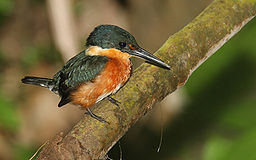- American Pygmy Kingfisher
-
American Pygmy Kingfisher 
male Conservation status Scientific classification Kingdom: Animalia Phylum: Chordata Class: Aves Order: Coraciiformes Family: Cerylidae Genus: Chloroceryle Species: C. aenea Binomial name Chloroceryle aenea
(Pallas, 1764)The American Pygmy Kingfisher, Chloroceryle aenea, is a resident breeding bird which occurs in the American tropics from southern Mexico south through Central America to western Ecuador, and then around the northern Andes cordillera in the east to central Bolivia and central Brazil. The species occupies the entire Amazon Basin and the Tocantins River drainage adjacent in Pará state Brazil. It also occurs on Trinidad.
This tiny kingfisher occurs in dense forests and mangroves along small streams or rivers with heavily vegetated banks. The unlined nest is in a horizontal tunnel up to 40 cm long made in a river bank, earth heap, or occasionally an arboreal termite nest. The female lays three, sometimes four, white eggs.
The American Pygmy Kingfisher is 13 cm long and weighs 18g. It has the typical kingfisher shape, with a short tail and long bill. It is oily green above, with a yellow-orange collar around the neck, rufous underparts and a white belly. The female has a narrow green breast band. Young birds resemble the adults, but have paler rufous underparts, no breast band, and speckled wings and flanks. It gives a weak tik or stony cht cht call.
There are two recognised subspecies of American Pygmy Kingfisher. The nominate southern C. a. aenea has two lines of white spots on the wings, and northern C. a. stictoptera has three or four lines of spots and a concealed white patch of feathers on the undertail. The two forms intergrade in central Costa Rica.
American Pygmy Kingfishers perch quietly on a low branch close to water before plunging in head first after small fish or tadpoles. They will also hawk for insects. They are quite tame, but easily overlooked as they sit silently amongst riverside branches.
Subspecies
Two subspecies are currently recognized, including the nominate subspecies:[2]
- Chloroceryle aenea aenea (Pallas, 1764)
- Chloroceryle aenea stictoptera (Ridgway, 1884)
References
- ^ "Chloroceryle aenea". IUCN Red List of Threatened Species. Version 2010.4. International Union for Conservation of Nature. 2009. http://www.iucnredlist.org/apps/redlist/details/142205. Retrieved 5 May 2011. Database entry includes justification for why this species is of least concern.
- ^ "Chloroceryle aenea". Integrated Taxonomic Information System. http://www.itis.gov/servlet/SingleRpt/SingleRpt?search_topic=TSN&search_value=554639. Retrieved 5 May 2011.
- ffrench, Richard (1991). A Guide to the Birds of Trinidad and Tobago (2nd edition ed.). Boston: Comstock Publishing. ISBN 0-8014-9792-2.
- Fry, C. H.; Fry, Kathie; Harris, Alan (1999). Kingfishers, Bee-eaters and Rollers. London: Christopher Helm. ISBN 0-7136-5206-3.
- Hilty, Steven L (2003). Birds of Venezuela. London: Christopher Helm. ISBN 0-7136-6418-5.
- Stiles, F. Gary; Skutch, Alexander F. (1990). A Guide to the Birds of Costa Rica. Ithaca, N.Y: Comstock Publishing. ISBN 0-8014-9600-4.
External links
- American Pygmy Kingfisher videos, photos & sounds on the Internet Bird Collection
- Stamps (for El Salvador) with RangeMap
- Photo; Article borderland-tours
- American Pygmy Kingfisher photo gallery VIREO Photo-High Res
Categories:- IUCN Red List least concern species
- Chloroceryle
- Birds of South America
- Birds of Brazil
- Birds of the Amazon Basin
- Birds of the Guianas
- Birds of the Cerrado
- Birds of the Pantanal
- Birds of Trinidad and Tobago
- Birds of Central America
- Birds of the Yucatán Peninsula region
- Birds of Guatemala
- Birds of El Salvador
- Birds of Costa Rica
- Birds of Mexico
- Native birds of Southern Mexico
- Birds of Colombia
- Birds of Venezuela
- Birds of Ecuador
- Birds of Peru
- Birds of Bolivia
- Birds of Paraguay
- Birds of Argentina
Wikimedia Foundation. 2010.

